The beginning of glyph line Ca2 was characterized by 'the heliacal rising' (in rongorongo times) of a star which anciently once had marked the March equinox and which at that time had literally been 'the First Point of Aries', viz. the star Sheratan (β) at the frontal horn of Aries: 
For practical reasons I am using our own well known Gregorian calendar as a 'map' in my presentations of the glyph texts rather than a structure developed from the right ascension hours, minutes, and seconds. Though the creators of the rongorongo texts used a solar calendar slightly different from ours.
However, the overall basic structure for the C text was perhaps not a specific calendar at all but instead an artistic composition derived from the positions of certain stars as determined by a 'spider web' of space coordinates equal or similar to our own current structure of lines for right ascension and declination ('latitude').
0h was in rongorongo times defined - I suggest - from the right ascension position of the star pair Caph and Sirrah, thereby also connecting this pair with March 21. I used the value 0.5 for their 'twin' position half a day later than 0h.
Maybe the correct position for Caph (β Cassiopeiae) and Sirrah (α Andromedae) should be 0.1 rather than 0.5 because η Andromedae would then have been precisely at 11.0 (instead of at my calculated value 11.4). The Arabs were evidently using η Andromedae as a kind of origin, this I have concluded after having assembled the following table:
But instead of adjusting my estimated RA positions for the stars, which I have used much time and effort to calculate, it ought to be enough for the moment to remember that they maybe should be reduced a little. There are 26 glyphs in line Ca1 and the first glyph in line Ca2 is therefore number 27 counted from the beginning of the text:
Since the ancient time when the star pair Sheratan and Mesarthim (γ Arietis) was used as a pointer for March 21 they (and all the rest of the stars in the sky roof) had glided forward in the year compared to the March equinox. Sun was rising a little earlier in each year which meant the stars in the night appeared to be shifting slowly forward correspondingly. From March 21 (80) to April 17 (107) there are 27 days and precession would have needed around 27 * 71 = 1917 years to move Sheratan and the other stars ahead with 27 days. Just before the beginning of the Christian era Sheratan and Mesarthim must have marked the March equinox. I have counted with 1870 A.D. as the upper limit for when the rongorongo texts were composed and at that time Sirrah would have risen with the Sun in March 21. The Mamari ('Egg') tablet is well preserved and should not be much older than 1870.
A.D. 1870 - 27 * 71 = 47 B.C. would accordingly have been the approximate year when Sheratan and Mesarthim together were rising with the Sun at the northern spring equinox. However, above in my presentation I have noted the year as 48 B.C. because our calendar makers once decided there should be no year zero (0 A.D. or 0 B.C.). Which is reasonable because a birth does not stretch for a whole year, normally it takes less than a day. Should we reduce my right ascension data with 0.4 this would correspond to a shift of my assumed time for the rongorongo texts from around 1870 A.D. to around 1870 - 0.4 * 71 = ca 1842 A.D. And then we would not have ca 48 B.C. for Sheratan and Mesarthim at March 21 but instead = ca 76 B.C. (76 - 48 = 28 = ca 0.4 * 71.) Our Gregorian calendar keeps track of Sun's path and adjusts the days automatically so that March 21 will always coincide (approximately) with the northern spring equinox and September 22 always with the southern spring equinox. There are 392 glyphs on side a of the tablet. Counted beyond the heliacal pair Sheratan / Mesarthim (the Arabs' Al Sharatain) at April 17 there were 392 - 27 = 365 days remaining to the end of the side. Maybe it meant the creator of the text wished to emphasize what important stars once, before the Christian era, had 'ruled' the March equinox. The era of Al Sharatain must have ended close before the beginning of the Christian era, when Sun left Sheratan / Mesarthim and therefore should be ruled by some other star rising earlier in the day. The Arabs' name for their 1st manzil Al Sharatain is plural of 'the Sign' because they had also Mesarthim (γ Arietis) - another star at the frontal horn of Aries - as a point of reference. The same method was used by the Hindus, whereas the Chinese preferred to rely only on β Arietis:
Both in the Arab and the Hindu calendar structures 'the First Point of Aries' (Sheratan and Mesarthim) was placed at the beginning and therefore I have noted number 1. The Chinese on the other hand had their Bond station as number 16 because they had placed their first station Horn at Spica (α Virginis), which in rongorongo times would have risen with the Sun around October 10. This 'horn' was not the horn of a ram but a 'horn' = ear (spike) of corn, which the Virgin had a multitude of in her left hand (as a sign opposite to the greenery in her right hand):
Greenery is growing upwards, whereas the grains in her left hand should be put down into the earth. Reading line Ca1 is consequently much like moving back against the arrow of time 2,000 years, and at the end of the glyph line then reach the time when Sun at March 21 had to leave the Ram 'who dwelled up on Land'. Much like reading backwards in time to the time when Sun had to move on to the next 'station' (constellation) in the order of time, which though was 'out in the Sea': ... This [σ Sagittarii] has been identified with Nunki of the Euphratean Tablet of the Thirty Stars, the Star of the Proclamation of the Sea, this Sea being the quarter occupied by Aquarius, Capricornus, Delphinus, Pisces, and Pisces Australis. It is the same space in the sky that Aratos designated as Water ... The distinction between 'Land' and 'Sea' was basic. The 'journey across the Sea' from March 21 to April 17 was, I think, in glyph line Ca1 and 'reaching Land' at the First Point of Aries would then be at the beginning of line Ca2. In his yearly cycle the Sun was advancing forward among the constellations but in the precessional cycle Time moved him in the opposite direction:
| |||||||||||||||||||||||||||||||||||||||||||||||||||||||||||||||||||||||||||||||||||||||||||||||||||||||||||||||||||||||||||||||||||||||||||||||||||||||||||||||||||||||||||||||||||||||||||||||||||||






